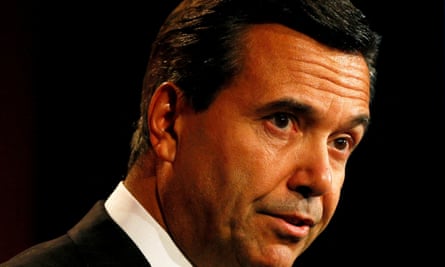As the chancellor, Kwasi Kwarteng, considers scrapping the bankers’ bonus cap, we look back at some of the largest City paydays of recent decades.
2006: Royal Bank of Scotland’s Fred Goodwin is paid £4m
Months before Royal Bank of Scotland was rescued in a £45bn taxpayer-funded bailout in 2008, the bank revealed that it had paid its chief executive Fred “the Shred” Goodwin £4m in 2006.
That was up 38% from a year earlier, and included a £1.2m salary and a bonus of £3.8m. Goodwin later ran into controversy after it emerged that he was granted a £16.9m pension pot that paid out nearly £700,00 a year.
The same year, RBS’s finance director Guy Whittaker took home £4.5m – the bulk of which was a share and cash payment that compensated him for bonuses he would have received at his former employer, Citigroup.
2011: Barclays’s Bob Diamond is paid £11m
Former investment banker turned chief executive Bob Diamond sparked controversy after he received a bumper pay packet worth £11m in 2011.
He had been granted a £1.35m salary, but also received a £2.7m share bonus, as well as £474,000 worth of perks including personal financial advice and chauffeurs. That was on top of share payouts and deferred payments pre-dating the financial crisis.
Diamond – who only led the bank for a year – was ousted as a result of the Libor rigging scandal. Barclays was the first bank to settle with the authorities over the controversy, paying £290m in 2012.
2011: HSBC’s Stuart Gulliver is paid £7.2m
The ex-chief executive of HSBC took home £7.2m in 2011, a year when he was allowed to earn three times his £1.25m salary as an annual bonus, and six times that total as part of a long-term incentive plan, which covered a three-year period.
He could have been paid a maximum £12.5m, but failed to reach key targets such as cost cuts return, strategy and reputation.
Overall, HSBC’s chairman Douglas Flint said the bank’s performance had been “satisfactory in aggregate” that year.
2014: Lloyds Banking Group’s António Horta-Osório is paid £11.5m
after newsletter promotion
The former boss of Lloyds Banking Group – which rescued HBOS from collapse and subsequently took a £20bn state bailout in 2008 – received his highest payout in 2011.
The package, which included a £7.5m bonus linked to a three-year pay scheme, attracted criticism from the Trades Union Congress, which said the excessive pay was an “outrage” for taxpayers who footed the bailout bill.

However, Lloyds’ then chairman Lord Blackwell said it was the result of a “tremendous” performance and fourfold rise in profits to £1.8bn that year.
2015: Standard Chartered’s Bill Winters is paid £8.4m
Bill Winters, a former investment banker at JP Morgan, was paid £8.4m in his first year on the job at emerging markets-focused lender Standard Chartered.
The figure was bolstered by a share-based buyout award, meant to compensate him for quitting Renshaw Bay, the hedge fund he was previously running. He had otherwise negotiated an annual salary of £1.15m alongside benefits of £35,000 and another £460,000 worth of annual pension pay.
Winters joined the bank just as it was launching a turn-around plan, after a damaging Iran sanction-busting scandal and a series of profit warnings.
